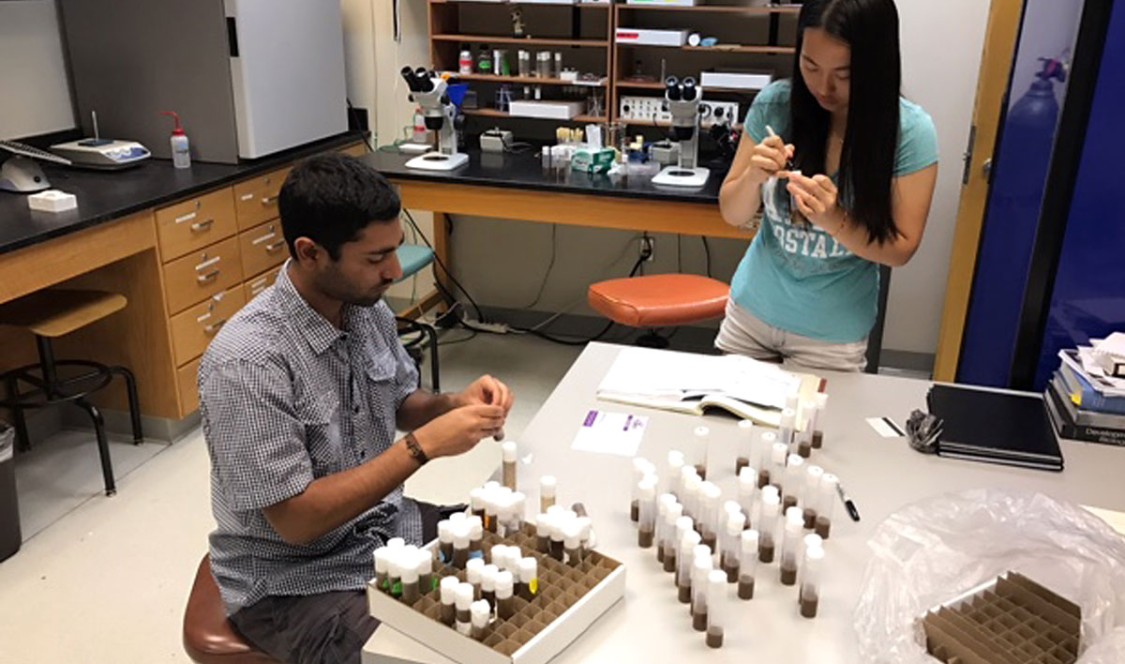It’s not every day that college undergraduates author an article published in a leading science journal. But that’s just what happened for CMC seniors Becky Cheng ’17 and Nitin Kuppanda ’17 last spring. They did the heavy lifting on a Current Biology paper about a bacterium that attacks and kills only males of a certain fruit fly species.
The study with the rather formidable title of “Male-Killing Spiroplasma Alters Behavior of the Dosage Compensation Complex during Drosophila melanogaster Embryogenesis” could help scientists combat insects that are pests to humans, including insects that carry disease-causing agents like Zika virus-carrying mosquitoes.
Cheng and Kuppanda, were co-authors of the study with Patrick Ferree, Associate Professor of Biology at the Keck Science Department.
“Becky and Nitin tackled some very complicated genetic crosses and helped analyze the results,” Professor Ferree says. “At some point in the study, Nitin began working on a completely unrelated project while Becky became the central orchestrator of the microscopy, which made up a bulk of the study. Becky put in hours and hours of tireless tissue prepping and imaging on our laser confocal microscope in Keck. Both Nitin and Becky helped with producing the original draft of the manuscript – it’s probably the first time I’ve had students actually critiquing my writing -- normally as an instructor it works in the reverse direction. They had strong input at that stage.”
Referring to the study, Prof. Ferree says that many animals carry bacterial symbionts (e.g., E. coli, the bacteria that live in our guts and help us digest nutrients). However, less well understood are bacteria that live completely within cells. These bacteria are typically transmitted from mother to offspring through her eggs. Males in contrast do not pass symbiotic bacteria.
According to Prof. Ferree, over time, certain maternally transmitted symbionts have gained the ability to manipulate the reproduction of their hosts to their own benefit. Typically, these symbionts bias the sex ratio of their hosts drastically toward the female sex (normally, any given animal's sex ratio would be 50:50 female to male). The idea is that more females translate into more efficient bacterial spread especially given that males are normally “dead ends” for symbiont transmission.
The study spanned more than 2½ years and focused on a bacterial symbiont,Spiroplasma, which naturally infects insects including the fruit fly Drosophila melanogaster. The researchers wanted to know how Spiroplasma is capable of selectively killing male hosts while sparing female hosts.
For the project, Cheng, a Science and Management major with a Biotechnology sequence, concentrated mainly on the method of cytology, staining Drosophila embryos and taking pictures of their cells. “I also contributed a little to the genetics at the beginning of the project and some of the writing mid-way through,” she says, adding that the experiments conducted during the project will make up the bulk of the lab research component for her thesis.
“I started this project during my freshman year and have been building upon it since then,” Cheng says. “I came into CMC knowing that I wanted to major in science and take part in something that I could contribute to throughout my four years in college, which ended up with me getting involved in research at Keck. I thought the research that Prof. Ferree was doing in his lab seemed really different and something that I would enjoy partaking in, so I spoke with him and joined his lab shortly after. I'm really glad that I made this choice because the skills and experiences that I have gained from lab have really helped both in my classes and non-class related activities.”
For his part, Kuppanda, a dual major in Biology and International and Intercultural Studies, joined the study because of his interest in how bacteria could cause sex ratio distortions and the mechanism that lay behind that. “In essence, I wanted to know how the bacteria differentiated in killing a male, while leaving a female relatively unaffected,” he says.
Cheng says the most challenging aspect of the project was when experiments went awry. “We just had to continue trying or make changes until we were able to get results,” she says. “Sometimes it would take months to get any results that we could use, but it felt really good and worthwhile when that time came. The most enjoyable part for me would be when we could sit down to look at images or data and deduce possible conclusions from them.”
Both students were excited when news came that the paper they co-authored would be published in Current Biology. “I studied abroad in Chile last spring semester and was in a rural town when I received the email,” Kuppanda says. “I told all my friends on the program and the academic director. It was a great experience to find out a project that we had been working on since freshman year was going to be published.”
According to Cheng, the study will have lasting value and is important in bringing new knowledge into the scientific community, specifically in the field of genetics and Drosophila research.
“I think that the findings from the project can help future researchers in this field by giving them something to build off of if they decide to investigate further,” she says. “All new scientific discoveries are important because they help increase our current knowledge, which can never be a bad thing.”
Prof. Ferree says that despite the in-depth study, more research can and should be done.
“What really must now be done is to figure out specifically how Spiroplasma is disrupting the dosage compensation machinery,” he says. “One aspect is to identify specifically which part of the machinery is targeted. We would also like to identify the toxin produced by Spiroplasma, and will be working collaboratively with a group at Brown University to do this. I won’t give away our secret plans but stay tuned!”

